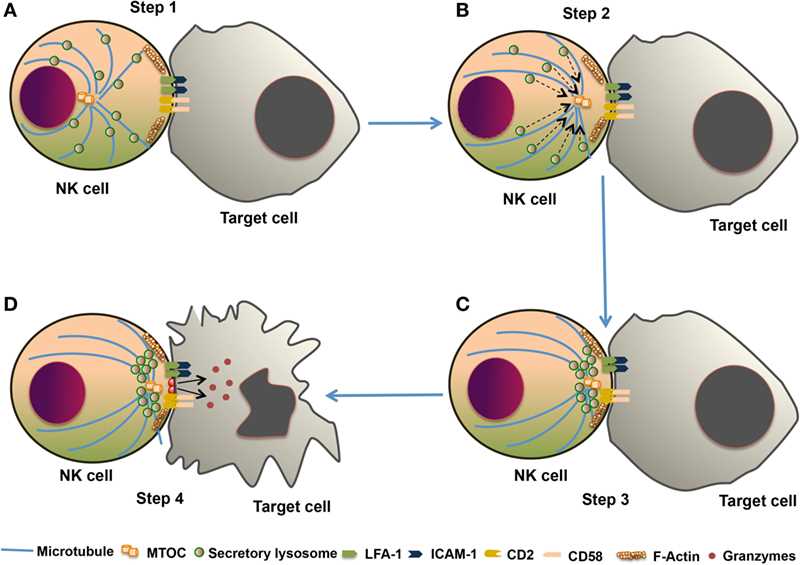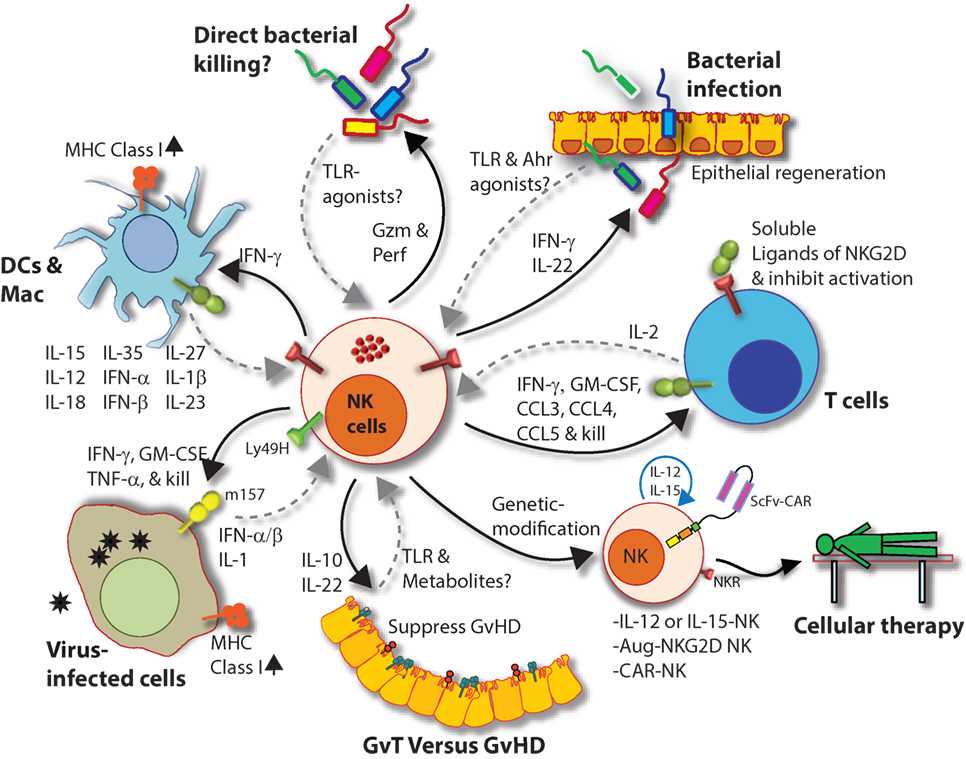Natural Killer Cell (NK Cell)
About Natural Killer Cell (NK Cell)
Natural killer or NK cells are a sub-population of Large Granular Lymphocytes (LGLs) which arise from a common NK/T-cell progenitor. Accumulating evidence indicates that NK cells can develop and mature both in the bone marrow and secondary lymphoid tissues (SLTs) including tonsils, spleen, and Lymph nodes (LNs). In the innate immune system, NK cells participate in early cytotoxic responses against viruses, parasites, microbial pathogens, as well as tumor immunosurveillance. Also, their protective and pathogenic roles have been more defined in the development of autoimmune diseases such as systemic lupus erythematosus, type I diabetes mellitus, and autoimmune liver disease. NK cell's function is regulated by various activating or inhibitory receptors. These germ-line encoded immunoreceptors on the surface of NK cells sense nonspecific alterations of self-cells caused by cellular stress, infections, or malignant transformation. In contrast, B and T lymphocytes in the adaptive arm, undergo gene rearrangement to generate surface receptors and mediate the antigen-specific immune responses.
While encountering normal cells, inhibitory receptors override activating receptors. However, molecular changes on the cell surface due to viral infection or tumor formation can stimulate the activating receptors. Upon activation, NK cells release granzyme, perforin, effector molecules of the TNF family, and Fas-ligand to induce apoptosis of the target cells. In addition, NK cells synthesize and release other cytokines and chemokines such as IL-10, gamma-interferon, and GM-CSF to recruit other immune effector cells to the target site. NK cells also exhibit antibody-dependent cell cytotoxicity against cells or target antigens which are marked with specific antibodies. Recently, therapeutic applications modulating the inhibition-activation dynamic of NK cells have been developed for multiple conditions including cancer, autoimmune disease, diabetes, etc.
Functions of NK Cells
Cytotoxicity: NK cells are highly cytotoxic and can directly kill target cells, such as virus-infected cells or cancer cells. They recognize abnormal cells by detecting changes in the expression of ligands on the cell surface. NK cells have a variety of activating receptors, including natural cytotoxicity receptors (NCRs) and killer cell immunoglobulin-like receptors (KIRs), which bind to ligands on target cells and trigger the release of cytotoxic granules containing perforin and granzymes. These granules induce apoptosis in the target cells.
Cytokine Production: NK cells produce an array of cytokines, such as interferon-gamma (IFN-γ), tumor necrosis factor-alpha (TNF-α), and interleukin-10 (IL-10). These cytokines have diverse effects on immune responses, including enhancing the activity of other immune cells, modulating inflammation, and promoting immune surveillance against infections and tumors.
Immunoregulation: NK cells also play a role in regulating immune responses. They can interact with other immune cells, such as dendritic cells and T cells, through cell-to-cell contact and cytokine signaling. NK cells can either enhance or suppress immune responses, depending on the context and the signals they receive.
Antibody-Dependent Cellular Cytotoxicity (ADCC): NK cells can recognize and eliminate target cells coated with antibodies. They express a receptor called CD16 (FcγRIIIa), which binds to the Fc portion of antibodies. This allows NK cells to bind to antibody-coated cells, such as virus-infected cells or tumor cells, and induce their destruction.
Pathophysiology of Natural Killer Cell (NK Cell)
 Fig. 1 The cytotoxic response of natural killer (NK) cells. (Sourav Paul, et al., 2017)
Fig. 1 The cytotoxic response of natural killer (NK) cells. (Sourav Paul, et al., 2017)
In addition to NK cell roles in defense against viral infections and tumor immunosurveillance, they have been linked to several other diseases including asthma, inflammatory bowel disease, and autoimmune diseases. Advancements in understanding the pathophysiology of NK cells resulted in the development of new therapeutic options and treatments. For instance, NK cells are found in the pancreas of patients with diabetes type I, and they enhance the disease development. Reducing the NK cell activation using specific blocking antibodies will prevent further disease progression.
As the largest lymphocyte population representing innate immunity, NK cells perform diverse functions. Through their ability to mediate killing and to produce soluble factors, NK cells perform multitudes of immunological functions.
- Counter-clockwise: bidirectional interactions between NK cells and dendritic cells (DCs)/macrophages result in priming. Activated DCs and macrophages generate interleukin (IL)-15, IL-12, IL-18, IL-35, IFN-α, IFN-β, IL-27, IL-1β, and IL-23. These, in turn, activate NK cells to be primed, proliferate, and produce inflammatory factors and chemokines such as interferon-gamma (IFN-γ), granulocyte/monocyte colony-stimulating factor (GM-CSF), tumor necrosis factor (TNF)-α, CCL3, CCL4, and CCL5.
- In addition, IFN-γ from NK cells can increase the MHC class I expression and the transcription of genes encoding immuno-proteasomal subunits in these professional antigen-presenting cells, and thereby augmenting T cell priming and activation.
- Similarly, virus-infected cells produce IFN-α, IFN-β, and IL-1β and present either “stress-induced” self-ligands or viral proteins on the cell surface that activate NK cells. A reduction in graft-versus-host disease (GvHD) is mediated through the production of IL-10 by the CD56brightCD16Neg NK cell subset and augmentation of GvT is potentiated via direct tumor killing by CD56dimCD16Pos NK cell subset.
- In addition, the production of IL-22 by NK subsets may help the regeneration of epithelial cells in the mucosal tissues. Irrespective of these observations, the mechanisms by which NK cells are activated to respond during active GvHD/GvT are not fully understood.
- Genetic manipulation of NK cells has helped to improve the effector functionality and longevity of human NK cells in vivo. Stable integration of gene encoding IL-15 into the genome of NK cells promotes sustained proliferation via an artificial autocrine loop.
- The bidirectional interaction between NK and T cells results in the regulation of adaptive immunity. IL-2 produced by CD4+ Th1 cells plays a vital role in the proliferation and expansion of NK cells.
- In addition, a cleaved soluble form of these ligands (MIC-A/B) is present in the serum of cancer patients. This, in turn, plays an important role in containing the effector functions of T cells via direct binding to the NKG2D receptor expressed on T cells. NK cells recognize bacteria-infected cells (such as epithelial cells) either using toll-like receptors (TLR) or by activated through soluble factors including aryl hydrocarbon receptor (Ahr). This results in the production of IFN-γ and IL-22 which helps with the reduction in bacterial load and regeneration of epithelial cells, respectively. NK cells can also directly mediate the lysis of bacteria using granzymes and perforin.
 Fig. 2 Natural killer (NK) cells in health and disease. (Alex M. Abel, et al., 2018)
Fig. 2 Natural killer (NK) cells in health and disease. (Alex M. Abel, et al., 2018)
Available Resources for Natural Killer Cell (NK Cell)
Creative BioMart offers a wide range of quality tools for NK cell research, including recombinant proteins and more. We provide personalized services according to the specific needs of our clients. In addition, we provide comprehensive resources covering all aspects of NK cells, including involved pathways, protein functions, interacting proteins, related articles, and other relevant topics to help advance NK cell research.
Our Featured Products
- Recombinant Human LAMP1, His tagged
- Active Recombinant Human CD160 Protein, His-tagged
- Active Recombinant Human CD160 Protein, His-tagged, FITC conjugated
- Recombinant Monkey CD160 Protein, His-tagged, FITC conjugated
- Active Recombinant Human CD244 protein, Fc & Avi-tagged, Biotinylated
- Recombinant Human CD244 Protein, Fc-tagged, Alexa Fluor 488 conjugate
- Recombinant Human CD244 Protein, His-tagged, FITC conjugated
- Recombinant Human CD48 protein, His-tagged
- Recombinant Human CD48 Protein, His-tagged, FITC conjugated
- Recombinant Human CRTAM, GST-tagged
- Active Recombinant Human SLAMF6 Protein, His-Avi-tagged, Biotinylated
- Recombinant Human SLAMF7 protein, hFc-tagged
- Recombinant Human TNFRSF8, Fc-His tagged
- Active Recombinant Human TNFSF8, Fc tagged
- Recombinant Human TNFSF8 Protein (I168A), His-tagged
- Recombinant Human PVR, None tagged
- Recombinant Human TLR4, His tagged
- Active Recombinant Human TREM2 protein, His-tagged
- Recombinant Human AXL, His tagged
- Recombinant Human CDH1, His tagged
- Recombinant Human FAS, His & GST tagged
- Recombinant Human IL15 protein
- Recombinant Human KLRC1, GST-tagged
- Recombinant Human MERTK protein
- Recombinant Human MICA protein, His-tagged
- Recombinant Human NCR3, Fc-His tagged
- Recombinant Human PVRL2, None tagged
- Recombinant Human TIGIT, GST-tagged
- Recombinant Human TNFSF10, His-tagged
- Recombinant Human ULBP1, His tagged
- Recombinant Human ULBP2, GST-tagged
If you have any questions, requirements, or cooperation intentions, please feel free to contact us. We very much look forward to working with you and helping you achieve research and commercial success.
References:
- Vivier E, Tomasello E, Baratin M, Walzer T, Ugolini S. Functions of natural killer cells. Nat Immunol. 2008;9(5):503-510. doi:10.1038/ni1582
- Abel AM, Yang C, Thakar MS, Malarkannan S. Natural Killer Cells: Development, Maturation, and Clinical Utilization. Front Immunol. 2018;9:1869. Published 2018 Aug 13. doi:10.3389/fimmu.2018.01869
- Chu J, Gao F, Yan M, et al. Natural killer cells: a promising immunotherapy for cancer[J]. Journal of Translational Medicine, 2022, 20(1):1-19. DOI:10.1186/s12967-022-03437-0.
- Sourav P, Girdhari L. The Molecular Mechanism of Natural Killer Cells Function and Its Importance in Cancer Immunotherapy[J]. Frontiers in Immunology, 2017, 8:1124-. DOI:10.3389/fimmu.2017.01124.


